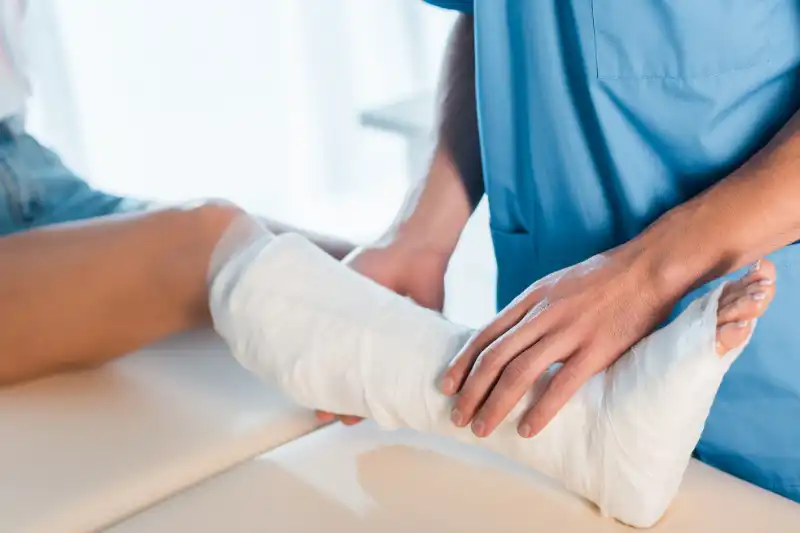Emergency Room for Fractures and Dislocations Care
Accidents happen to the best of us, a stumble, a misstep, a bump; it’s a part of life. Typically, it’s no cause for concern, just a minor hiccup. However, there are instances when the impact is more serious, leading to fractures or dislocations. According to the CDC, approximately one in five falls results in a significant injury, be it a head injury, fracture, or broken bone. While children and the elderly may be more vulnerable, with kids engaging in active play and bone density decreasing with age, the reality is that fractures and dislocations can occur unexpectedly to anyone. The faster you seek medical attention, the better your chances of proper healing and avoiding even worse injuries down the line. If you think you have suffered a fracture or dislocation, don’t wait, get the help you need at a Surepoint ER nearest you.

What Are Fractures and Dislocations?
When a bone breaks, it’s called a fracture. Fractures can be minor or severe, depending on the amount of force that caused the break. A fracture happens when the force applied to a bone is stronger than the bone itself. There are 4 main types of fractures:
- Stress fractures: These are tiny cracks that develop in a bone over time.
- Closed fractures: The bone breaks or cracks without breaking the skin.
- Open or compound fractures: The bone breaks through the skin.
- Comminuted fractures: The bone breaks into multiple pieces.
A dislocation is a different kind of injury that happens when a bone in a joint gets forced out of place. This makes the joint unable to move and can cause swelling and deformity. Dislocations often happen in the shoulders, elbows, fingers, hips, knees, and ankles. There are 5 main types of dislocations:
- Subluxation: A partial or incomplete dislocation of a joint.
- Anterior Dislocation: Occurs when the affected joint is thrust forward out of the socket toward the front of the body.
- Posterior Dislocation: Takes place when the affected joint is pushed backward out of the socket toward the rear of the body.
- Inferior Dislocation: Involves the affected joint being compelled downward out of the socket toward the lower part of the body.
- Superior Dislocation: Involves the affected joint being pushed upward out of the socket toward the upper part of the body.
While some medical conditions might not get worse if treatment is delayed, fractures and dislocations are not among them. Start by getting a proper diagnosis to understand the injury. Seek medical help promptly to ensure the right treatment plan for speedy recovery.
Surepoint is Open 24/7 Near You!
If you are experiencing severe pain or any other serious fractures or joint dislocation symptoms, please visit a Surepoint ER nearest you. We are open 24-7, no appointment needed.
What Causes Fractures and Dislocations?
Almost any joint in your body, including ankles, knees, shoulders, hips, elbows, and even finger and toe joints, can experience dislocation. Fractures can result from various causes, such as falls, accidents, direct blows, repetitive stress, or underlying medical conditions like Osteoporosis. Participating in sports or having a profession involving repetitive tasks (e.g., painting or lifting) may increase the risk of fractures and dislocations. If you feel severe pain, notice visible bruising, swelling, or experience symptoms like difficulty moving the affected area, seek immediate attention at a Surepoint ER near you.
What Are the Signs and Symptoms of Fractures and Dislocations?

Dislocations and fractures are common bone and joint injuries. Sometimes, these injuries go unnoticed because people might not immediately recognize them. For instance, in sports like football, a child might get tackled, hear a snap or popping sound, and keep playing, assuming the injury isn’t severe because they can still move the affected area. Another reason these injuries might not receive immediate attention is the misconception that a broken bone or dislocation should be visibly obvious, such as a bone sticking out. In reality, fractures or dislocations don’t always present obvious signs; even a small break or crack can result in these injuries. Common signs and symptoms of fractures and dislocations include:
Symptoms of a Bone Fracture:
- Visible misalignment or deformity of a limb or joint
- Swelling, bruising, and signs of bleeding
- Intense pain at the injury site
- Sensations of numbness and tingling
- Broken skin and protruding bone
- Limited mobility and inability to move the affected limb
Symptoms of a Dislocation:
- Pain localized in the affected area
- Swelling is evident in the affected area
- Bruising around the dislocated joint
- Instability experienced at the joint
- Loss of ability to move the joint
- Visibly deformed appearance of the joint
Should I Go To The ER If I Have Fractures or Dislocations?
Dealing with broken bones and dislocated joints can be incredibly painful. While our bones are sturdy, they have limits, and excessive force can lead to fractures or dislocations. If you think you might have a fracture or dislocation, it’s important to get medical care fast. A medical professional needs to identify the exact cause of your pain using X-rays and imaging before starting treatment. These diagnostic tools help them pinpoint fractures and other injuries. For fractures, the treatment may involve a splint, brace, or cast to stabilize the broken bone while it heals. In the case of a dislocation, your doctor may recommend medications, a sling or splint, repositioning the bone, and possibly rehabilitation. It’s important never to attempt to pop the dislocated joint back into place on your own. When deciding whether to visit the emergency room for a suspected fracture or dislocation, consider these factors:
Severity of The Injury:
- If you have a severe injury, that is causing extreme pain, swelling, or difficulty breathing, you should go to the ER immediately.
Location of The Injury:
- If the injury is located in a critical area, such as the head, neck, spine, or pelvis, it’s best to go to the ER.
Age and Health Status:
- If you are elderly or have a pre-existing medical condition, such as heart disease or diabetes, it’s important to consider the potential risks associated with delaying treatment. In such cases, it’s generally recommended to err on the side of caution and visit the ER.
Open Fractures or Wounds:
- If there’s an open fracture or wound with visible bone, seek immediate medical attention to prevent infection and minimize further damage.
Numbness or Tingling:
- If you experience numbness or tingling beyond the injury site, it may indicate nerve involvement, requiring prompt medical evaluation.
Instability and Loss of Function:
- In cases of joint dislocation or severe fractures that compromise stability and function, urgent medical attention is crucial to prevent complications.
If you have a bone sticking out of your skin or are experiencing loss of warmth beyond the injured area, or have any other severe fracture or dislocation symptoms, don’t wait, head to the closest Surepoint ER near you for fast and effective care.
Treating Fractures and Dislocations at Surepoint ER
When bones break or joints pop out of place, we use a mix of methods like keeping things still, medications, and physical therapy to help you heal. To determine the best fracture or dislocation treatment method, we start by taking X-rays and images to understand what’s going on beneath the skin. Common treatments for fractures and dislocations include:
- Immobilization with splints or casts
- Medication for pain management
- Physical therapy for strengthening and range of motion exercises
- Surgical intervention for complex fractures or dislocations
- Reduction of dislocations under sedation or anesthesia
- Lifestyle modifications to accommodate healing and prevent future injuries
Our Tips For Preventing Fractures and Dislocations at Surepoint ER

Fractures and dislocations can be challenging to avoid, even with precautions. People with severe osteoporosis or underlying medical conditions may experience bone breaks or joint dislocations from mild bumps or simple actions like bending over or coughing. While some incidents are accidental and unpredictable, you can take action to reduce your risk for fractures and dislocations. Here are some common tips to prevent fractures and dislocations at Surepoint ER:
- Eat Right: Make sure you get enough calcium and vitamin D either from your diet or supplements. This helps keep your bones strong.
- Stay Active: Include activities like walking or strength training in your routine to strengthen your bones and improve overall stability.
- Watch Your Step: Be cautious to avoid falls. Remove things that you might trip over, use handrails, and wear appropriate shoes.
- Check Your Bones: If you’re at risk, consider getting a bone density test to see how healthy your bones are and take the necessary steps.
- Safety at Home: Make your home safer by installing grab bars in bathrooms, securing rugs, and ensuring good lighting to prevent accidents.
- Live Healthy: Avoid smoking and limit alcohol intake, as these habits can harm your bone health.
- See Your Doctor: Schedule regular check-ups with healthcare professionals to monitor your overall health, especially conditions that may affect your bones.
- Protect Yourself: In activities like sports, use the right protective gear to reduce the risk of injuries.
- Improve Balance: Do exercises that enhance balance and coordination to lower the chances of accidental falls.
- Act Quickly: If you notice any signs of bone or joint issues, don’t hesitate to see a doctor promptly. Addressing the problem early can prevent it from getting worse.
Don’t Overlook the Signs: Fast Action Is Needed for Severe Fractures and Dislocations Emergencies!
If you’re worried about signs like persistent pain, swelling, or difficulty moving a limb that could indicate severe fractures or dislocation symptoms, Surepoint Emergency Centers are open 24/7, no appointment necessary, ready to help. Click the link below to find a Surepoint ER near you and get the care you need today!





